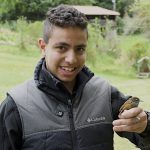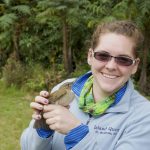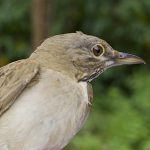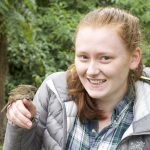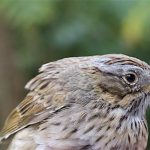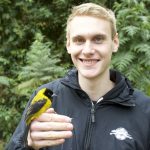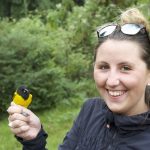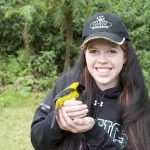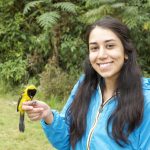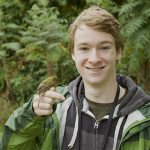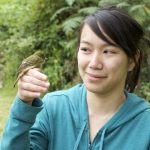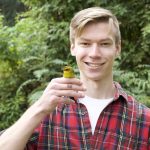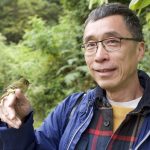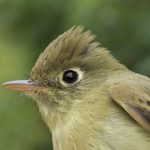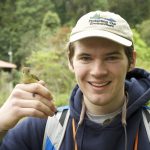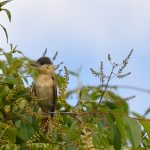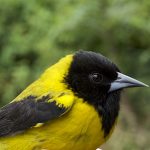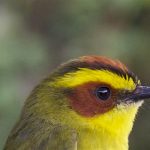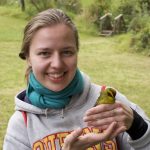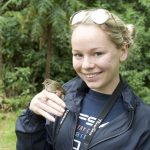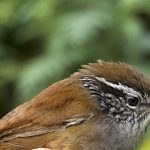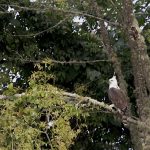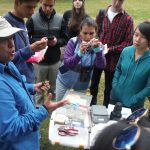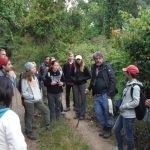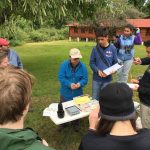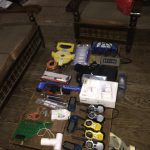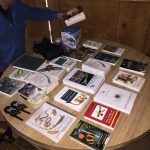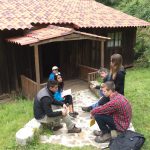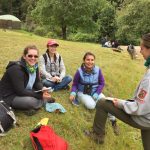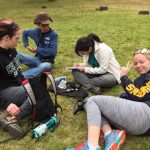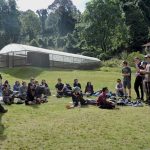ENGLISH
February 16, 2017: Field Day #2:
After a phenomenal first full day at Las Joyas, and hopefully sufficient sleep for all, we jumped into our second field day with coffee in our mugs and field books in our hands. The day was moist, foggy, and rather chilly, with a few instances of sun interspersed throughout the afternoon. As the group congregated around 6:45 AM, the dawn chorus began to fill the soundscape, starting with such Mexican gems such as the blue mockingbird (Melanotis caerulescens), various solitaires (Myadestes), the forest falcon (Micrastur) and the Audubon Oriole (Icterus graduacauda). A re-sighting of the hawk eagle (Spizaetus ornatus) followed later.
After learning mist net basics from Professor Salgado yesterday evening, the class engaged in setting up five mist nets in three different locations. Professor Salgado, along with the Mexican students, directed the assembly of the nets, and the students from Queen’s aided and applied their learning from the evening before. Later on, we circled back to the first nets to see if any birds had been caught in the nets. The first birds identified in the nets were a white-throated thrush (Turdus assimilis) and a grey-breasted wood wren (Henicorhina leucophrys). The rest of the mist nets were sampled and dismantled. Once the mist nets were taken care of, we fueled up with a refreshing breakfast of fresh papaya, beans, eggs, and again, some more coffee.
Back at the bio-station HQ, Professor Salgado gave the class an informative and impassioned interactive lecture on the ecology, physiology, and behaviours of the birds that the class had collected. Each student got to feel the sheer vibrating force of the Amethyst-throated hummingbird’s (Lampornis amethystinus) heart, which roared away at around 600 BPM. Pictures of the photoshoot are attached, with students holding several endemic jewels from the western coast of Mexico. Some of the key takeaways that we took from this hands-on learning experience were ornithological measurement parameters and procedures, blood sampling techniques, and how to handle the birds with care. Lunch consisted of fish tacos with assorted vegetables, and vegetarian sushi.
As the mild day passed on, we had some time to split off into our project-groups and ruminate on potential hypotheses for our course projects and write-ups. Dr. Lougheed directed a collaborative discussion period under the infamous “tree of wisdom” as each group presented their ideas, observations, hypotheses, and even potential experimental set-ups. From arthropods to angiosperms, and herbivory to habitat selection, each group had made unique observations and put their scientific minds to work, ready to start data collection. We also had mentions of the distribution of the ubiquitous “orange spaghetti” that we have come to know and appreciate on this trip.
A herp-walk in the early evening yielded few finds and fewer catches; however, we were duped by a nest-experiment along the sides of the path, which led some students to think they had stumbled upon a series of quail nurseries. We were educated and entertained by the seminars of Nicole Duic, Daniel Khalil, Sam McCaul, and Kalen Gabriel, on the topics of the origins, patterns, and diversity of mammals, reptiles, amphibians, and birds in Mexico. To cap off the meals for the day, we enjoyed delicious Mexican pizza, which was truly a smash hit among students and professors alike.
Overall, we had an astounding second day at Las Joyas, and the station is already starting to feel a bit more like a second home, thanks to the wonderful hospitality of the culinary and operations staff of the property, as well as the warmth and charity of the Mexican students. We are looking forward to commencing our projects, and to the next few days of learning and laughing at Las Joyas!
ESPAÑOL
Febrero 16, 2017: Segundo día de campo
Depués de un fenomenal primer día en Las Joyas, y esperando tener suficiente tiempo para dormer, comenzamos nuetro Segundo día de campo con una taza de café y libretas de campo en nuestras manos. Amanecio con niebla, húmedo y con algo de frío, con algunos ratos soleados durante el transcurso de la mañana. A medida que nos reuniamos a las 6:45 am, el coro matutino de aves mexicanas comenzó a llenar el paisaje, con cantos como los del Mulato azul (Melanotis caerulescens), varios Jilgueros (Myadestes), el Halcón Selvático (Micrastur) y la Calandria de Audubon (Icterus graduacauda). Luego observamos al Águila crestada (Spizaetus ornatus).
Despues de una práctica de campo sobre el uso de redes ornito´logicas con el Profesor Salgado durante la tarde del día anterior, todo el grupo nos fuimos a practicar a poner otras cinco redes en otros sitios. Junto con los estudiantes Mexicanos, el Dr. Salgado dirijieron la colocación de las redes a los estudiantes de Queen´s con base en lo aprendido la tarde del día anterior. Más tarde nos reunimos para ir a revisar si había pájaros atrapados en las redes. Encontramos una Primavera parda (Turdus assimilis) y un saltabreñas (Henicorhina leucophrys). Despues de un rato, se cerraron las redes y nos fuimos al desayuno que incluyó papaya fresca, frijoles, huevo revuelto y nuevamente más café.
De regreso en la estación, el Profesor Salgado dos dió una catedra sobre la ecología, fisiología y conducta de las aves, con los ejemplares capturados. Cada estudiante tuvimos la experiencia de tocar el motor vibrante de la fuerza del corazón de un colibrí (Lampornis amethystinus) a una velocidad de 600 lpm. Incluimos varias fotos de los estudiantes tomando varios pájaros de especies endémicas de México en nuestras manos. Algunos de las técnicas adicionales que aprendidos en esta experiencia práctica, fueron medidas morfométricas y procedimientos para la toma de muestras de sangre además de la forma de como tomar las aves en las manos. Nos fuimos despues a comer unos tacos de pescado con ensalada y para los vegetarianos Sushi vegetariano.
A medida que el día transcurría, tuvimos tiempo de trabajar en equipos para nuestros proyectos y discutir las hipótesis potenciales para los proyectos del curso. El Dr. Lougheed dirigío una discusion muy participative bajo la sombre del nada famóso ¨árbol de la sabiduría” mientras cada equipo presentaba sus ideas, observaciones, hipótesis y los posibles diseños experimentales. Desde artrópodos hasta angiospermas, herbivoría y selección de habitat, cada equipo present sus observaciones y pusieron sus mentes científicas a trabajar para comenzar la colecta de datos. Hasta tuvimos una discusión sobre la distribución del famoso “spagueti naranja” (Planta parasite) que a todos llamó la atención en este viaje.
Seguimos poco más tarde con una caminata para la búsqueda de reptiles, pero no hubo suerte, sin embargo, encontramos unos nidos que llamaron nuestra atención a lo largo del borde del camino que nos llevó a pensar que se trataba de un sitio de anidación de codornices, pero eran nidos artificiales. Por la noche tuvimos seminaries presentados por Nicole Duic, Daniel Khalil, Sam McCaul y Karen, con varios temas sobre los orígenes, patrones y la diversidad de mamíferos, aves, reptiles y anfibios de México. Para rematar el gran día, cenamos deliciosa “Pizza Mexicana” que en realidad eran molletes deliciosos para todos.
En general, tuvimos un segundo día extraordinario en las Joyas y la estación ya comenzó a sentirse como una segunda casa gracias a la gran hospitalidad y experiencia culinaria del personal de la estación y la calidez y Amistad de los estudiantes mexicanos. Esperamos ansiosos iniciar nuestros proyectos y seguir disfrutando y aprendiendo los siguientes días que nos quedan en Las Joyas !
